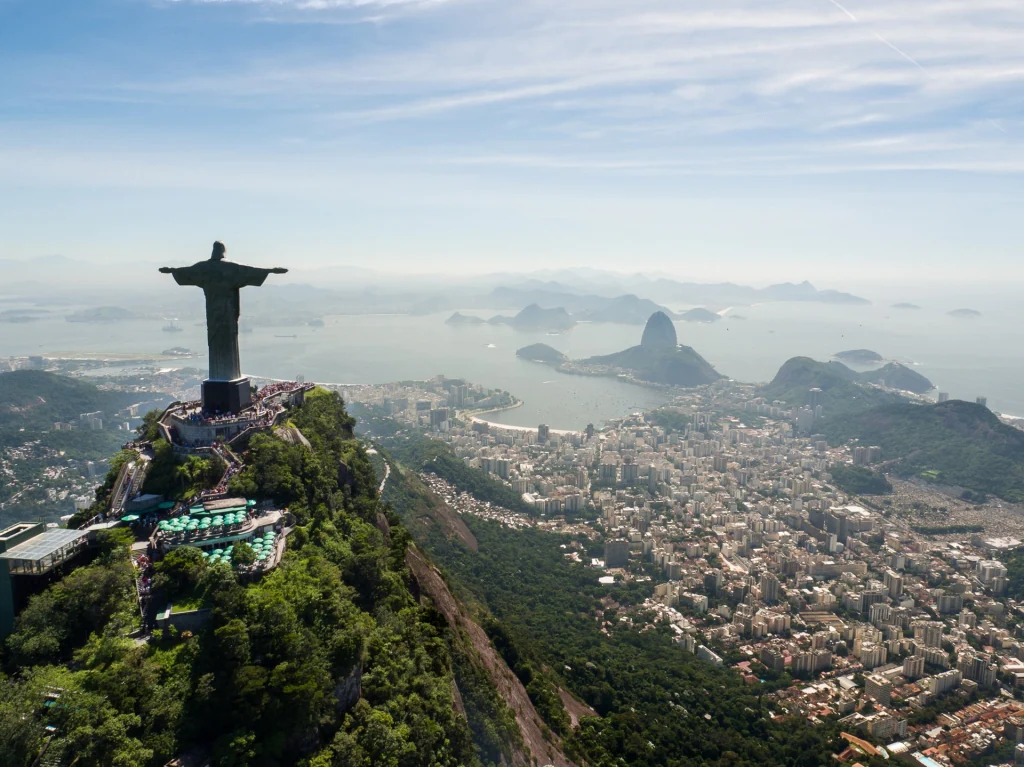South America is a region known for its natural beauty, vibrant cultures, and diverse economies. While some countries may face economic challenges, others have achieved impressive growth and wealth. In this post, we will be exploring the top 10 richest countries in South America for 2023.
From established economic powerhouses to emerging markets, these countries boast strong GDP per capita and a range of industries driving their growth. Let’s take a closer look at the economic landscape of South America and the top performers in the region.
| Country | GDP per capita |
|---|---|
| Chile | $25,110.20 |
| Uruguay | $22,793.70 |
| Argentina | $20,770.70 |
| Guyana | $19,704.60 |
| Suriname | $16,734.70 |
| Colombia | $14,931.00 |
| Brazil | $14,835.40 |
| Paraguay | $13,069.20 |
| Peru | $11,878.50 |
| Ecuador | $10,895.80 |
| Bolivia | $8,275.50 |
| Venezuela | $5,162.00 |
Chile – $25,110.20
Chile is one of the wealthiest countries in South America, with a strong and stable economy. Its GDP per capita of $25,110.20 is one of the highest in the region, and its economy is largely based on exports of copper and other minerals. Chile has also developed a strong service sector, particularly in finance, tourism, and logistics.
The country has a reputation for sound economic management and has been able to weather various global economic crises relatively well. The combination of a stable political environment, strong institutions, and open market policies have helped Chile maintain a high standard of living for its citizens and attract foreign investment.
Uruguay – $22,793.70
Uruguay is a small country in South America with a relatively wealthy population. Its GDP per capita of $22,793.70 is one of the highest in the region, and its economy is largely based on agriculture, particularly the production and export of beef and dairy products.
In recent years, Uruguay has also developed a strong service sector, particularly in the areas of tourism, finance, and software development. The country has a strong social welfare system and a commitment to democracy, making it an attractive destination for foreign investors and expatriates.
Uruguay has also been successful in attracting foreign investment in renewable energy, particularly wind power. Despite its relatively small size, Uruguay has a strong and diverse economy and has managed to weather various global economic crises relatively well.
Argentina – $20,770.70
Argentina is one of the largest and most populous countries in South America, with a rich and diverse cultural heritage. Its GDP per capita of $20,770.70 places it in the upper-middle-income bracket, and its economy is largely based on agriculture, manufacturing, and services. Argentina is a leading producer and exporter of agricultural commodities, including soybeans, corn, and wheat.
The country is also a significant producer of industrial goods, including automobiles and steel. The service sector is a growing part of the Argentine economy, with particular strengths in the areas of finance, tourism, and technology. However, Argentina has faced significant economic challenges in recent years, including high inflation, a large fiscal deficit, and a difficult external environment.
Despite these challenges, Argentina remains a significant economic player in the region and has the potential to continue growing and developing in the coming years.
Read also: Top 10 Richest Cricketers In The World In 2023
Guyana – $19,704.60
Guyana is a small country located on the northern coast of South America, with a population of approximately 800,000 people. Its GDP per capita of $19,704.60 places it in the upper-middle-income bracket, and its economy is largely based on natural resources. Guyana is a leading producer of gold, bauxite, and timber, and has significant reserves of oil and natural gas.
In recent years, the country has also developed a growing service sector, particularly in the areas of finance, tourism, and telecommunications. Despite its relatively small size, Guyana has significant potential for economic growth, particularly in the energy sector. The recent discovery of oil reserves is expected to significantly boost the country’s economy in the coming years.
However, Guyana also faces significant challenges in terms of infrastructure, education, and healthcare, and will need to address these issues in order to fully realize its economic potential.
Suriname – $16,734.70
Suriname is a small country located on the northern coast of South America, with a population of approximately 600,000 people. Its GDP per capita of $16,734.70 places it in the upper-middle-income bracket, and its economy is largely based on natural resources. Suriname is a leading producer of bauxite, gold, and oil, and has significant reserves of other minerals as well.
The country also has a small but growing service sector, particularly in the areas of finance and tourism. Despite its relative wealth in natural resources, Suriname faces significant challenges in terms of infrastructure, education, and healthcare.
The country has made progress in recent years in addressing these issues, but more work remains to be done. In addition, the country’s economy is vulnerable to fluctuations in commodity prices, making diversification an important goal for Suriname’s economic development.
Colombia – $14,931.00
Colombia is a large and diverse country located in the northwest of South America, with a population of over 50 million people. Its GDP per capita of $14,931.00 places it in the lower-middle-income bracket, and its economy is largely based on natural resources and manufacturing. Colombia is a leading producer of oil, coal, and emeralds, and has significant reserves of other minerals as well.
The country also has a well-developed manufacturing sector, particularly in the areas of textiles, food and beverages, and chemicals. In recent years, Colombia has also developed a growing service sector, particularly in the areas of finance, tourism, and technology. Despite its relative wealth in natural resources, Colombia faces significant challenges in terms of inequality, violence, and political instability.
The country has made progress in recent years in addressing these issues, but more work remains to be done to ensure inclusive and sustainable economic growth for all Colombians.
Brazil – $14,835.40
Brazil is the largest country in South America, with a population of over 210 million people. Its GDP per capita of $14,835.40 places it in the lower-middle-income bracket, and its economy is one of the largest and most diversified in the region. Brazil is a leading producer and exporter of agricultural commodities, including soybeans, coffee, and beef.
The country also has a well-developed manufacturing sector, particularly in the areas of automobiles, electronics, and chemicals. In recent years, Brazil has also developed a growing service sector, particularly in the areas of finance, technology, and tourism. Despite its relative wealth and economic diversity, Brazil faces significant challenges in terms of inequality, corruption, and environmental degradation.
The country has made progress in recent years in addressing these issues, but more work remains to be done to ensure sustainable and inclusive economic growth for all Brazilians.
Paraguay – $13,069.20
Paraguay is a landlocked country located in the heart of South America, with a population of approximately 7 million people. Its GDP per capita of $13,069.20 places it in the lower-middle-income bracket, and its economy is largely based on agriculture and natural resources. Paraguay is a leading producer of soybeans, corn, and beef, and has significant reserves of other minerals as well.
The country also has a growing manufacturing sector, particularly in the areas of textiles, food and beverages, and construction materials. Despite its relative wealth in natural resources, Paraguay faces significant challenges in terms of poverty, inequality, and corruption.
The country has made progress in recent years in addressing these issues, but more work remains to be done to ensure inclusive and sustainable economic growth for all Paraguayans.
Peru – $11,878.50
Peru is a country located on the western coast of South America, with a population of over 32 million people. Its GDP per capita of $11,878.50 places it in the lower-middle-income bracket, and its economy is largely based on natural resources and mining. Peru is a leading producer of gold, copper, and zinc, and has significant reserves of other minerals as well.
The country also has a growing manufacturing sector, particularly in the areas of textiles, food and beverages, and chemicals. In recent years, Peru has also developed a growing service sector, particularly in finance, technology, and tourism.
Despite its relative wealth in natural resources, Peru faces significant challenges in terms of poverty, inequality, and corruption. The country has made progress in recent years in addressing these issues, but more work remains to be done to ensure sustainable and inclusive economic growth for all Peruvians.
Ecuador – $10,895.80
Ecuador is a country located on the west coast of South America, with a population of approximately 17 million people. Its GDP per capita of $10,895.80 places it in the lower-middle-income bracket, and its economy is largely based on exports of oil and other commodities. Ecuador is also a leading producer of bananas, flowers, and shrimp, and has significant reserves of other minerals as well. The country also has a growing service sector, particularly in the areas of finance, technology, and tourism.
Despite its relative wealth in natural resources, Ecuador faces significant challenges in terms of poverty, inequality, and corruption. The country has made progress in recent years in addressing these issues, but more work remains to be done to ensure sustainable and inclusive economic growth for all Ecuadorians.
Bolivia – $8,275.50
Bolivia is a landlocked country located in the central region of South America, with a population of approximately 11 million people. Its GDP per capita of $8,275.50 places it in the lower-middle-income bracket, and its economy is largely based on natural resources and mining.
Bolivia is a leading producer of tin, silver, and zinc, and has significant reserves of other minerals as well. The country also has a growing manufacturing sector, particularly in the areas of textiles, food and beverages, and chemicals. In recent years, Bolivia has also developed a growing service sector, particularly in the areas of finance, technology, and tourism. Despite its relative wealth in natural resources, Bolivia faces significant challenges in terms of poverty, inequality, and corruption.
The country has made progress in recent years in addressing these issues, but more work remains to be done to ensure sustainable and inclusive economic growth for all Bolivians.
Venezuela – $5,162.00
Venezuela is a country located on the northern coast of South America, with a population of approximately 28 million people. Its GDP per capita of $5,162.00 (IMF estimate) places it in the low-income bracket, and its economy is largely based on oil exports. Venezuela has the largest oil reserves in the world, but its economy has been in decline in recent years due to political instability, corruption, and mismanagement of resources.
Inflation has soared to unprecedented levels, and there have been shortages of essential goods and services. The country’s manufacturing sector has also been hit hard by economic difficulties, leading to a decline in exports. Despite these challenges, Venezuela has a highly educated population and a diversified economy in other sectors, such as agriculture, mining, and tourism.
However, significant reforms and investments are needed to stabilize the country’s economy and address the social and economic challenges facing Venezuelans.
Conclusion
In conclusion, South America is a diverse region with varying levels of economic development and prosperity. While some countries like Chile and Uruguay have high GDP per capita figures and well-diversified economies, others like Venezuela and Bolivia face significant economic and social challenges.
Nonetheless, the region as a whole has significant potential for growth and development, given its rich natural resources, diverse industries, and highly skilled workforce. As countries in the region continue to invest in infrastructure, education, and innovation, there is hope that they can overcome their challenges and achieve sustainable and inclusive economic growth in the years to come.
FAQ | Top 10 Richest Countries in South America 2023
Who is the richest country in South America?
The richest country in South America is Chile, with a GDP per capita of $25,110.20.
Which is the poorest country in South America?
The poorest country in South America is Venezuela, with an estimated GDP per capita of $5,162.00 according to the IMF.
What is the most successful country South America?
The most successful country in South America can be subjective, but many consider countries like Brazil and Chile to be successful in terms of their economies and political stability.
Who has the strongest South American economy?
Currently, Brazil has the strongest South American economy in terms of GDP.
What are the 3 richest nations in South America?
The three richest nations in South America, in descending order, are Chile, Uruguay, and Argentina.
Which country is richest in Asia?
The richest country in Asia is currently Qatar, with a GDP per capita of $59,330.50.
What is the safest country in South America?
Uruguay is often considered the safest country in South America, with low levels of crime and political stability.
Which country is better to live in South America?
Countries like Uruguay, Chile, and Argentina are often considered better places to live in South America due to their quality of life, healthcare, and education systems.
What is the most developed city in South America?
The most developed city in South America can be subjective, but cities like São Paulo, Buenos Aires, and Santiago are often considered the most developed.
What is the main religion in South America?
The main religion in South America is Christianity, with Catholicism being the predominant branch.
What is the cheapest South American country to live in?
Bolivia is often considered the cheapest South American country to live in.
Which is safest country in Asia?
Countries like Japan, Singapore, and Taiwan are often considered the safest countries in Asia.
What is the 1 poorest country in Asia?
The poorest country in Asia is currently Afghanistan, with a GDP per capita of $584.90.
Which country has worst crime rate?
It is difficult to determine which country has the worst crime rate, as crime statistics can vary widely depending on the source and methodology.
Which country is Asia cleanest?
Again, it can be difficult to determine which country in Asia is the cleanest, but countries like Singapore and Japan are known for their cleanliness and environmental policies.














+ There are no comments
Add yours